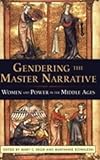Gendering the Master Narrative : Women and Power in the Middle Ages / ed. by Mary C. Erler, Maryanne Kowaleski.
Material type: TextPublisher: Ithaca, NY : Cornell University Press, [2018]Copyright date: ©2003Description: 1 online resource (280 p.) : 3 tables, 2 maps, 17 halftonesContent type:
TextPublisher: Ithaca, NY : Cornell University Press, [2018]Copyright date: ©2003Description: 1 online resource (280 p.) : 3 tables, 2 maps, 17 halftonesContent type: - 9781501723957
- Literature, Medieval -- Women authors -- History and criticism
- Narration (Rhetoric) -- History -- To 1500
- Narration (Rhetoric)
- Power (Social sciences)
- Rhetoric, Medieval
- Social history -- Medieval, 500-1500
- Women and literature -- History -- To 1500
- Women and literature -- Europe -- History -- To 1500
- Women in literature
- Women -- History -- Middle Ages, 500-1500
- Literary Studies
- Medieval & Renaissance Studies
- HISTORY / Medieval
- 305.4/09/02 21
- HQ1143 .G46 2003
- online - DeGruyter
| Item type | Current library | Call number | URL | Status | Notes | Barcode | |
|---|---|---|---|---|---|---|---|
 eBook
eBook
|
Biblioteca "Angelicum" Pont. Univ. S.Tommaso d'Aquino Nuvola online | online - DeGruyter (Browse shelf(Opens below)) | Online access | Not for loan (Accesso limitato) | Accesso per gli utenti autorizzati / Access for authorized users | (dgr)9781501723957 |
Frontmatter -- CONTENTS -- ABBREVIATIONS -- Introduction. A New Economy of Power Relations: Female Agency in the Middle Ages -- CHAPTER ONE. Women and Power through the Family Revisited -- CHAPTER TWO. Women and Confession: From Empowerment to Pathology -- CHAPTER THREE. "With the Heat of the Hungry Heart": Empowerment and Ancrene Wisse -- CHAPTER FOUR. Powers of Record, Powers of Example: Hagiography and Women's History -- CHAPTER FIVE. Who Is the Master of This Narrative? Maternal Patronage of the Cult of St. Margaret -- CHAPTER SIX. "The Wise Mother": The Image of St. Anne Teaching the Virgin Mary -- CHAPTER SEVEN. Did Goddesses Empower Women? The Case of Dame Nature -- CHAPTER EIGHT. Women in the Late Medieval English Parish -- CHAPTER NINE. Public Exposure? Consorts and Ritual in Late Medieval Europe: The Example of the Entrance of the Dogaresse of Venice -- CHAPTER TEN. Women's Influence on the Design of Urban Homes -- CHAPTER ELEVEN. Looking Closely: Authority and Intimacy in the Late Medieval Urban Home -- REFERENCES -- CONTRIBUTORS -- INDEX
restricted access online access with authorization star
http://purl.org/coar/access_right/c_16ec
Gendering the Master Narrative asks whether a female tradition of power might have existed distinct from the male one, and how such a tradition might have been transmitted. It describes women's progress toward power as a push-pull movement, showing how practices and institutions that ostensibly enabled women in the Middle Ages could sometimes erode their authority as well.This book provides a much-needed theoretical and historical reassessment of medieval women's power. It updates the conclusions from the editors' essential volume on that topic, Women and Power in the Middle Ages, which was published in 1988 and altered the prevailing view of female subservience by correcting the nearly ubiquitous equation of "power" with "public authority." Most scholars now accept a broader definition of power based on the interactions between men and women.In their Introduction, Mary C. Erler and Maryanne Kowaleski survey the directions in which the study of medieval women's agency has developed in the past fifteen years. Like its predecessor, this volume is richly interdisciplinary. It contains essays by highly regarded scholars of history, literature, and art history, and features seventeen black-and-white illustrations and two maps.
Mode of access: Internet via World Wide Web.
In English.
Description based on online resource; title from PDF title page (publisher's Web site, viewed 26. Apr 2024)


